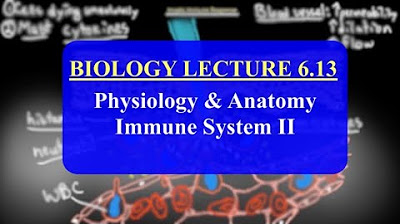Structure and Immune Function of the Lymphatic System
Summary
TLDRThis video delves into the intricate structure of the immune system, focusing on the lymphatic system's vital role in coordinating immune responses. It explains how immune cells, particularly B and T lymphocytes, recognize foreign antigens and interact within lymph nodes to activate and mount defenses against pathogens. Key organs such as the spleen, thymus, and mucosa-associated lymphoid tissues (MALT) are highlighted for their functions in filtering blood, T cell development, and protecting mucosal surfaces from infection. Overall, the video provides a comprehensive overview of how the immune system operates and maintains balance to prevent overreactions.
Takeaways
- 🎢 Disneyland revolutionized the theme park experience by prioritizing immersive storytelling and guest engagement.
- 🌍 The park's global presence has allowed it to adapt marketing strategies to different cultures and demographics.
- ✨ Disneyland's attention to detail creates a magical atmosphere, enhancing guest satisfaction and loyalty.
- 🎉 Innovative events and seasonal celebrations are key to attracting repeat visitors and maintaining excitement.
- 💻 Digital advancements have transformed guest experiences, from mobile apps to virtual queuing systems.
- 🎠 Disneyland emphasizes nostalgia in its marketing, appealing to generations of fans through classic characters and stories.
- 📈 The park uses data analytics to tailor promotions and enhance guest experiences, driving higher attendance rates.
- 🛍️ Merchandise plays a crucial role in Disneyland's revenue, integrating characters and themes into diverse product lines.
- 👨👩👧👦 Family-centric marketing approaches position Disneyland as a destination for all ages, fostering multi-generational visits.
- 🤝 Strategic partnerships and collaborations have expanded Disneyland's reach and appeal, enhancing its brand image.
Q & A
What role does the lymphatic system play in the immune response?
-The lymphatic system is crucial for transporting lymph, which contains immune cells, cellular waste, and potential pathogens, allowing immune cells to recognize foreign antigens and coordinate an immune response.
How do immune cells recognize foreign threats?
-Immune cells recognize foreign threats by identifying specific molecules called antigens that are found on infectious microbes and diseased cells. They also require co-stimulatory signals from other immune cells for full activation.
What are the two main types of lymphocytes and their functions?
-The two main types of lymphocytes are B cells and T cells. B cells produce antibodies to neutralize infectious microbes, while T cells recognize and kill infected or cancerous self-cells.
What is the significance of antigen presentation in T cell activation?
-Antigen presentation is critical because T cells can only recognize their cognate antigen when it is bound to surface proteins on other cells, allowing them to become activated and carry out their immune functions.
How do lymph nodes facilitate the activation of immune cells?
-Lymph nodes act as strategic outposts where immune cells can meet and exchange activation signals. They are organized into distinct compartments for B and T cells, allowing for efficient interactions and immune responses.
What are the primary functions of the spleen?
-The spleen has two main functions: it removes old red blood cells from circulation and filters pathogens and immune complexes from the blood. It contains red pulp for blood filtration and white pulp for immune response coordination.
What is the role of the thymus in the immune system?
-The thymus is essential for the early development of T cells. It provides an environment for T cell progenitors to mature and differentiate before entering the bloodstream and lymphatic system.
What is Mucosa-Associated Lymphoid Tissue (MALT), and where is it found?
-MALT is a collection of lymphatic tissues found in mucosal surfaces, including the digestive tract, airways, and other areas. It helps protect these surfaces from infections and regulate immune responses.
How do specialized B cells in the spleen respond to pathogens?
-In the spleen, marginal zone B cells can quickly respond to blood-borne threats without requiring T cell help. They effectively sense and neutralize pathogens that enter the marginal zone.
What mechanisms do mucosal surfaces employ to prevent unnecessary immune activation?
-Mucosal surfaces utilize regulatory responses to maintain tolerance to harmless substances, such as food and benign bacteria, while still being able to mount an immune response against true threats.
Outlines

このセクションは有料ユーザー限定です。 アクセスするには、アップグレードをお願いします。
今すぐアップグレードMindmap

このセクションは有料ユーザー限定です。 アクセスするには、アップグレードをお願いします。
今すぐアップグレードKeywords

このセクションは有料ユーザー限定です。 アクセスするには、アップグレードをお願いします。
今すぐアップグレードHighlights

このセクションは有料ユーザー限定です。 アクセスするには、アップグレードをお願いします。
今すぐアップグレードTranscripts

このセクションは有料ユーザー限定です。 アクセスするには、アップグレードをお願いします。
今すぐアップグレード5.0 / 5 (0 votes)






